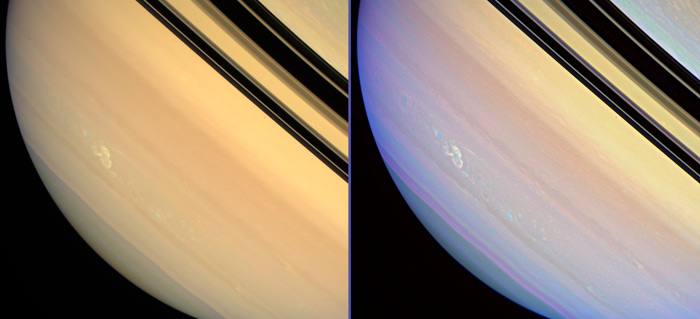Long-Lived Lightning Storm Rages on Saturn

A monsterstorm spawning bolts of lightning 10,000 times more powerful than any seen onEarth is raging on the ringed planet Saturn.
Thepowerful electrical storm cropped up in Saturn?s southern hemisphere fivemonths ago, when it was first spotted by NASA?sCassini spacecraft, and has persevered to become the planet?s longest continuouslyrecorded tempest to date.
"Wesaw similarstorms in 2004 and 2006 that each lasted for nearly a month, but this stormis longer-lived by far,? said Georg Fischer, an associate with Cassini?s radioand plasma wave science team at the University of Iowa, Iowa City, in astatement. ?And it appeared after nearly two years during which we did notdetect any electrical storm activity from Saturn."
Cassini?sradio and plasma wave science instrument first picked up signals from the storm?slightning bursts on Nov. 27, 2007, with the probe?s cameras catching theirfirst visual glimpse on Dec. 6. Images of the storm show it as a smudge onSaturn?s otherwise creamy cloud bands.
"Theelectrostatic radio outbursts have waxed and waned in intensity for five monthsnow," Fischer said.
Electricalstorms on Saturn are similar to thunderstorms on Earth, but much larger. Theycan span thousands of miles and generate radio bursts fromlightning that can be thousands of times more powerful than Earthly lightning bolts,said mission scientists, who named a massive lightning storm in 2004 ?Dragon."
The currentelectrical tempest is mired in a region of Saturn that mission scientists have dubbed?Storm Alley" because of its frequent and intense storms. Every few seconds thestorm belches intense radio pulses consistent with lightning that can bedetected even when the weather itself is over the horizon and out of directview from Cassini.
Breaking space news, the latest updates on rocket launches, skywatching events and more!
Researchershope that by tracking the Saturnian weather, they may gain new insights intothe processes behind the planet?s lightning, as well as how it changes as theseasons shift from summer to autumn in Saturn?s southern hemisphere.
?In orderto see the storm, the imaging cameras have to be looking at the right place atthe right time, and whenever our cameras see the storm, the radio outbursts arethere," said Ulyana Dyudina, a Cassini imaging team associate at theCalifornia Institute of Technology in Pasadena, Calif.
Cassini?sonboard instruments have tracked the storm every 10 hours and 40 minutes, whenSaturn?s rotation brings it into view, though amateur astronomers are alsowatching over the tempest from Earth.
"SinceCassini's camera cannot track the storm every day, the amateur data areinvaluable," said Fischer. "I am in continuous contact withastronomers from around the world."
Launched in1997, Cassini arrived at Saturn in 2004 and has spotted a series of odd stormswhile studying the ringed planet and its many moons. The probe has captured views of a hurricane-likestorm near the south pole of Saturn and recorded a massivelightning storm about 2,175 miles wide (3,500 kilometers) wide in 2006.
Earlierthis year, managers for the international Cassini-Huygens mission, whichincludes NASA, and the European and Italian space agencies, extended the probe?s$3.27 billion expedition by two additional years to 2010. ??
- The Wildest Weather in the Galaxy
- VIDEO: Enceladus, Cold Faithful
- IMAGES: Cassini's Latest Discoveries

Tariq is the award-winning Editor-in-Chief of Space.com and joined the team in 2001. He covers human spaceflight, as well as skywatching and entertainment. He became Space.com's Editor-in-Chief in 2019. Before joining Space.com, Tariq was a staff reporter for The Los Angeles Times covering education and city beats in La Habra, Fullerton and Huntington Beach. He's a recipient of the 2022 Harry Kolcum Award for excellence in space reporting and the 2025 Space Pioneer Award from the National Space Society. He is an Eagle Scout and Space Camp alum with journalism degrees from the USC and NYU. You can find Tariq at Space.com and as the co-host to the This Week In Space podcast on the TWiT network. To see his latest project, you can follow Tariq on Twitter @tariqjmalik.
